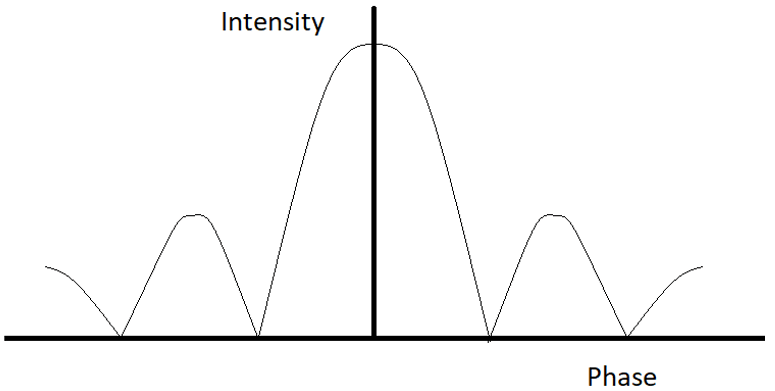This set of Engineering Physics Multiple Choice Questions & Answers (MCQs) focuses on “Diffraction of Light”.
1. What changes are observed in a diffraction pattern if the whole apparatus is immersed in water?
a) The Wavelength of light increases
b) Width of central maximum increases
c) Width of central maximum decreases
d) Frequency of light decreases
View Answer
Explanation: As the whole apparatus is now immersed in water, the wavelength of the light will change.
λ’=\(\frac{\lambda}{\mu}\)
Therefore, as the refractive index of water is greater than the air, the wavelength of light will decrease.
Width of central maxima = \(\frac{2\lambda}{a}\)
Therefore, as the wavelength decreases, the width of the central maxima decreases.
2. How shall a diffraction pattern change when white light is used instead of a monochromatic light?
a) The pattern will no longer be visible
b) The shape of the pattern will change from hyperbolic to circular
c) The colored pattern will be observed with a white bright fringe at the center
d) The bright and dark fringes will change position
View Answer
Explanation: When white light is used instead of monochromatic light, then the central maximum remains white as all seven wavelengths meet there in the same phase. The first minimum and second maximum will be formed by violet color due to its shortest wavelength while the last is due to the red color as it has the longest wavelength. Thus, a colored pattern is observed.
However, after the first few colored bands, the clarity of the band is lost, due to overlapping.
3. If the Fresnel’s distance is a, then what should be the distance of the screen from the slit, d, such that ray optics is no longer valid?
a) d > a
b) d < a
c) d = a
d) No relation between d and a
View Answer
Explanation: As long as d < a, the concepts of ray optics cannot be used directly. The distance at which the spreading of light due to diffraction becomes equal to the size of the slit is known as Fresnel’s distance.
4. Sound waves cannot be diffracted.
a) True
b) False
View Answer
Explanation: Diffraction is the bending of waves around a corner. Sound waves can also be diffracted. The fact that we can hear sounds around corners and around barriers is due to the diffraction of sound as well as its reflection.
5. The following pattern is observed for which experiment?

a) Fabry-Perot Interferometer
b) Double Slit Fraunhofer Diffraction
c) Single Slit Fraunhofer Diffraction
d) Fresnel Diffraction
View Answer
Explanation: In Fraunhofer single slit diffraction, the intensity of the fringes keeps decreasing as shown in the figure. There is a central maximum with a width of twice the fringe width.
6. What will be the angular separation of the first order fringe from the central maximum, when a light of wavelength 500 nm is diffracted at a slit of width 0.5 mm?
a) 2.1 minute
b) 3.4 minute
c) 4.8 minute
d) 5.6 minute
View Answer
Explanation: a = 0.5 mm = 0.5 X 10-3m, λ = 5000 Å = 5 X 10-7 m.
Angular separation between the central maximum and the first order minimum is given by:
sin θ = \(\frac{\lambda}{a}\) = 0.001
sin θ ≈ θ
θ = 0.001 radian
θ = 3.4 minute.
7. A diffraction pattern is obtained with a straight edge using light of wavelength 5500 Å. The separation between the edge and the source is 15 cm while that between the edge and the eyepiece is 3 m. What is the position of the first maximum?
a) 1.01 cm
b) 2.03 cm
c) 0.46 cm
d) 1.56 cm
View Answer
Explanation: λ = 5500 Å = 5.5 X 10-5cm, a = 15 cm and b = 300 cm
Location for first maximum, x1 = \(\frac{3b(a+b)}{a}\)
= 1.01 cm.
8. A screen is placed 2m away from the lens to obtain the diffraction pattern in the focal plane of the lens in a single slit diffraction experiment. What will be the slit width if the first minimum lies 5 mm on either side of the central maximum when plane light waves of wavelength 4000 Å are incident on the slit?
a) 0.16 mm
b) 0.26 mm
c) 0.36 mm
d) 0.46 mm
View Answer
Explanation: Given: f = 2 m, x = 5 X 10-3 m, λ = 4 X 10-7 m, n=1
sin θ = \(\frac{nλ}{a}\), we have
a = \(\frac{nλ}{sinθ}\)
= 1.6 X 10-4m
= 0.16 mm.
9. X-ray crystallography uses which characteristic of light?
a) Polarization
b) Interference
c) Diffraction
d) Coherency
View Answer
Explanation: X-ray crystallography is used to identify the molecular and atomic structure of the crystal. The crystal diffracts the incident X-ray beam. By measuring the intensities and angle of these diffracted beams, the molecular structure of the crystal can be evaluated.
10. By observing the diffraction patter, the two images are said to be just resolved when ________
a) The central maxima of one image coincide with central maxima of the other
b) The central maxima of one do not coincide with central maxima of the other
c) The central maxima of one image coincides with the first minimum of the other
d) The central maxima of one image do not coincide with the first minimum of other
View Answer
Explanation: In Rayleigh’s Criterion, the diffraction pattern formed is considered for resolution. According to him, two nearby images would be just resolved when the central maxima of one image coincide with the first minimum of the other and vice versa.
Sanfoundry Global Education & Learning Series – Engineering Physics.
To practice all areas of Engineering Physics, here is complete set of 1000+ Multiple Choice Questions and Answers.
If you find a mistake in question / option / answer, kindly take a screenshot and email to [email protected]
